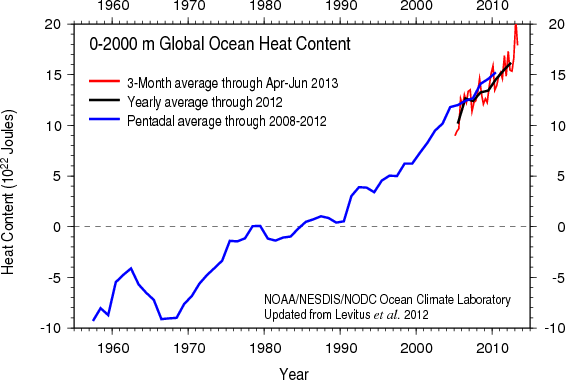The heat content of the oceans is growing and growing. That means that the greenhouse effect has not taken a pause and the cold sun is not noticeably slowing global warming.
NOAA posts regularly updated measurements of the amount of heat stored in the bulk of the oceans. For the upper 2000 m (deeper than that not much happens) it looks like this:
Change in the heat content in the upper 2000 m of the world’s oceans. Source: NOAA
The amount of heat stored in the oceans is one of the most important diagnostics for global warming, because about 90% of the additional heat is stored there (you can read more about this in the last IPCC report from 2007). The atmosphere stores only about 2% because of its small heat capacity. The surface (including the continental ice masses) can only absorb heat slowly because it is a poor heat conductor. Thus, heat absorbed by the oceans accounts for almost all of the planet’s radiative imbalance.
If the oceans are warming up, this implies that the Earth must absorb more solar energy than it emits longwave radiation into space. This is the only possible heat source. That’s simply the first law of thermodynamics, conservation of energy. This conservation law is why physicists are so interested in looking at the energy balance of anything. Because we understand the energy balance of our Earth, we also know that global warming is caused by greenhouse gases – which have caused the largest imbalance in the radiative energy budget over the last century.
If the greenhouse effect (that checks the exit of longwave radiation from Earth into space) or the amount of absorbed sunlight diminished, one would see a slowing in the heat uptake of the oceans. The measurements show that this is not the case.
The increase in the amount of heat in the oceans amounts to 17 x 1022 Joules over the last 30 years. That is so much energy it is equivalent to exploding a Hiroshima bomb every second in the ocean for thirty years.
The data in the graphs comes from the World Ocean Database. Wikipedia has a fine overview of this database. The data set includes nine million measured temperature profiles from all of the world’s oceans. One of my personal heroes, the oceanographer Syd Levitus, has dedicated much of his life to making these oceanographic data freely available to everyone. During the Cold war that even landed him in a Russian jail for espionage for a while, as he was visiting Russia on his quest for oceanographic data (he once told me of that adventure over breakfast in a Beijing hotel).
How to deny data
Ideologically motivated “climate skeptics” know that these data contradict their claims, and respond … by rejecting the measurements. Millions of stations are dismissed as “negligible” – the work of generations of oceanographers vanish with a journalist’s stroke of a pen because what should not exist, cannot be. “Climate skeptics’” web sites even claim that the measurement uncertainty in the average of 3000 Argo probes is the same as that from each individual one. Thus not only are the results of climate research called into question, but even the elementary rules of uncertainty calculus that every science student learns in their first semester. Anything goes when you have to deny global warming. Even more bizarre is the Star Trek argument – but let me save that for later.

Dados dos últimos 500 mil anos, indicam que o campo magnético da Terra é quem controla a temperatura do fundo dos oceanos. A radiação visível solar não é afetada diretamente pelo campo magnético. A quantidade que chega aos oceanos é afetada pelo albedo. Talvez, por algum processo, o albedo é afetado pelo campo magnético. Controlando o fluxo de raios cósmicos?
ResponderExcluir